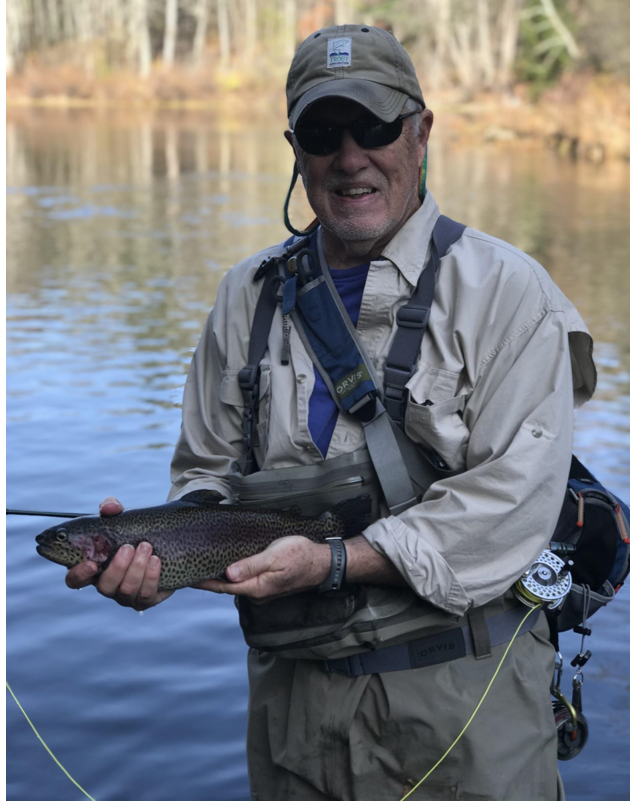WRITING ON THE FLY
By GEORGE LISET
I have been to many of the great rivers out west, some of them a number of times, but unfortunately, not with a fly rod in my hands. I have visited West Yellowstone, Jackson Hole, Cody and Casper, but like many people of my generation I took the responsible and respectable route and found a job out of college, started a business, found a wonderful woman to put up with me and my foibles, raised three wonderful children and took family vacations to some of the most beautiful and amazing places in the lower 48.
Although I always fished, mostly salt water, it wasn’t until my children were older and I finally had some disposable income that I could pursue fly fishing. Working and raising a family in New Hampshire, I seemed to be always driving by a great looking trout stream on the way to a family function or attending a meeting for work. I would dream about throwing a line in the water, but until then I would only read about it.
I would read about the big Cutthroat Trout out west. I would see pictures of some of the most incredible scenery in Montana, Wyoming and Colorado. Having seen most of it already it was not hard to imagine. It was the fly rod part I was missing. Until then, I would hone my skills on the mountain streams, ponds and rivers of New Hampshire. I would carry my fly rod and shoulder pack and waders in my truck. I knew every local spot where I could put a line in on a moment’s notice. My go-to river was the Cocheco, which through the efforts of Great Bay Trout Unlimited 613, Three Rivers Stocking and New Hampshire Fish and Game, held some nice fish.
When time allowed, I would slowly expand my travels. I would get out my map and look for blue lines. I was searching for water that did not have much fishing pressure and would allow for the feeling of solitude and isolation, something that is hard to find anywhere unless you spend thousands of dollars for a remote fly in the northernmost territories.
Then I found it. I will call it the Big Little River. The Big Little River was 35 minutes from my house, nestled between two small mountains. The lower part of the river is well known by fly fisherman, but feeling adventurous one day, I grabbed my light 3 weight rod and sling pack, put on my wet wading gear and hiked up to its source.
The scenery on the walk in was typical New England. As the path narrowed, I came to an overgrown family plot. The plot was surrounded by an overgrown stonewall. The entrance featured remnants of an iron gate. The headstones were slate and in disrepair. I always stop and pay my respects and admiration for the farmers who tried to make a meager living off this rocky soil.
If you have spent any time walking the woods of New Hampshire and New England in general, one will encounter the iconic overgrown stonewall that is embedded into the thick forestation and seems to run off to nowhere. It wasn’t until I had a conversation with a colleague who teaches history that I learned why this occurred. During the Civil War, many of the New England farmers who served were introduced to the more fertile farmlands of Pennsylvania, Maryland and Virginia. Upon their return, they sold their farms and moved to greener and less rocky pastures. The exodus was so rampant that some farmers could not find buyers and just up and left.
When I reached the water, I slowly walked up stream. The Big Little River at its headwaters is wide enough that you could step over it. At some points, younger legs could jump over it. The prize for this hike is the 3-5” Brookie. If you get a big one, it could get to 6”. The icing on the cake is knowing that they are wild and in the Fall, their colors will give the foliage a run for their money.
I approach the first little pool with the stealth of a Black Bear. I unhook my # 22 caddis off the hook keeper and debate a bow and arrow cast, but now I am dreaming, so I gently swing the tip of the rod and fly up stream and nymph the fly down. On the third swing through I get a bite. The tip of the light rod is bobbing up and down as I carefully bring the 3” fish in. The little guy puts up a fight befitting a trout twice its size.
There will not be any articles on “Fighting Native Three inch Trout” or “How I Hunted New Hampshire Brookies.” There will just be the satisfaction that I can enjoy my native rivers until I can visit out west with a fly rod in my hands.
George Liset of Dover is an outdoor writer and avid fly fisherman who shares insights of his time on the water exploring New Hampshire streams and rivers as well of those around New England. George is a graduate of Wheaton College, Illinois, and the University of New Hampshire.
Credit: Source link





























